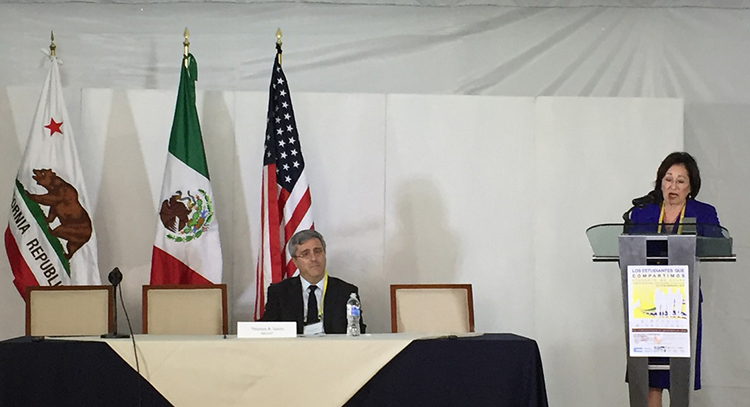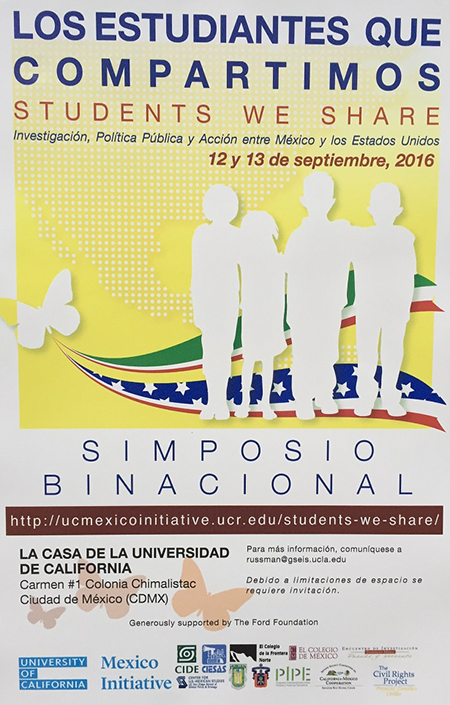Educational Needs of ‘Students We Share’ Go Unmet
University of California Mexico Initiative symposium examines educational experiences of students who attend school on both sides of the border, seeks solutions to improve learning opportunities
Media Contact:
- Anthony King - anthonypking@ucsd.edu
Published Date
Share This:
Article Content

From left, keynote speaker Thomas A. Saenez, president of the Mexican American Legal Defense and Educational Fund, with Patricia Gandara of UCLA opening day of “The Students We Share.” Photo courtesy of the Center for U.S.-Mexican Studies
The United States and Mexico share hundreds of thousands of students, but their educational needs too often go unmet and their potential is imperiled because of poor communication, bureaucratic challenges, language barriers and inadequate and unequal educational opportunities on both sides of the border, said educational researchers from both countries.
Research presented Sept. 12-13 in Mexico City at “The Students We Share/Los Estudiantes que Compartimos,” a bi-national symposium exploring new research findings on the experiences of students who attend school on both sides of the border, show that more than 400,000 U.S.-born school-age children and their families are currently trying to find their way in Mexican schools.
Additionally, students who return to Mexico and fail to enroll in school are not counted in these numbers but constitute a highly vulnerable group. Another 700,000 Mexican children in the U.S., as well as millions of U.S.-citizen children of Mexican parents, share parallel struggles in the U.S.

The two-day symposium was held in Mexico City Sept. 12-13.
“These students — bright, bilingual and bicultural — represent a tremendous asset for both of our countries, but too often they are caught in an educational no-man’s land where the struggles of school systems to communicate, needless bureaucratic requirements and language barriers undermine learning opportunities,” said Patricia Gandara, chair of the UC-Mexico Initiative Education Working Group and co-director of the Civil Rights Project at UCLA. “We need to work together to understand the issues confronting students and schools and improve learning opportunities in both countries.”
Presentations from the Center for U.S.-Mexican Studies (USMEX) at UC San Diego’s School of Global Policy and Strategy included research conducted through the Mexico Migration Field Research Project. USMEX interim director Melissa Floca discussed the educational performance of students in the municipality of Tijuana and Sweetwater Union High School District, finding that 90 percent of these students have ties to each country. These students have big aspirations for their futures, Floca said, however they face important barriers to their success.
Working with USMEX, Ana Barbara Mungaray of the Universidad Autonoma de Baja California (UABC) presented a discussion on the socioeconomic conditions the same border students, taking into account the employment status of their parents, access to resources relevant to education, and physical and emotional health. These elements, she said, are relevant for understanding the problems related to the educational performance of young bi-national students and their transition to adulthood.
“The lack of coherent policy and communication is resulting in a massive loss of human talent, a loss of the very young people who could serve as bridges between the two nations and throughout the hemisphere,” said Max Matus, a researcher at El Colegio de la Frontera Norte (COLEF) in Tijuana and co-coordinator of the symposium with Gandara.

The symposium is a project of the University of California Mexico Initiative and highlights a partnership between UC San Diego, COLEF, UCLA and UC Riverside. Seven Mexican institutions of higher education in Mexico served as co-conveners, including CIDE, CIESAS, COLMEX, Instituto Mora, PIPE, UABC and UdeG. The Institute for Mexicans Abroad (IME) of the Secretary of Foreign Relations (SRE) and the U.S. Embassy are also participating.
Symposium organizers contend not enough attention has been focused on the impact of incoherent immigration policies and almost totally uncoordinated education policies that impact large numbers of students whose lives and education are divided by a border that separates not only families but different phases of young people’s education. Researchers and policymakers gathered at the symposium to study the issues and develop public policy options for optimizing the educational and workforce development of Mexican-origin students in the United States and Mexico.
Among the finding presented at the symposium:
- Of the U.S.-born students (U.S. citizens) who have returned to Mexico, approximately 40,000 are residing in the border area of Northern Baja California.
- More than nine-tenths of the U.S. students of Mexican origin were born in the U.S. and are citizens, but many have at least one parent who is not. Forced repatriation to Mexico of parents creates a huge life-crisis for their U.S. citizen, English-speaking children.
- Major impediments to accessing schools in Mexico for returning students are bureaucratic procedures and documents that returnees do not have. In spite of a change in the law that stipulates returnees do not have to meet these requirements, this barrier continues to exist is some places in Mexico.
- Mexican origin children are concentrated in California, Texas and the Southwest, and large centers in New York, Florida, Illinois and a few other states. Populations are growing rapidly in the Southern and Midwestern states of the U.S., where there are comparatively few resources and little knowledge of how to address their needs.
- Language barriers present significant challenges. U.S.-born students returning to Mexico are often held back because they cannot read and write in Spanish, and Mexico offers no programs to transition them. Additionally, it is estimated that no more than 5 percent of teachers nationwide in Mexico are proficient in English and the capacity to teach English is very limited. Similarly, fewer than 5 percent of U.S. teachers are certified as bilingual, and many teachers lack the necessary training and skills to effectively teach children whose native language is Spanish.
- There are vast inequalities in educational offerings in both countries with children of Mexican origin being schooled in some of the most segregated and impoverished schools in the U.S., and low income and rural children in Mexico score a full standard deviation lower than their higher peers in Mexico.
- Higher education admissions requirements are varied, unsystematic and opaque, and governed by different entities at the federal and state levels. Systems are not responsive to inquiries from returning students.
“Our research makes clear that on both sides of the border, Mexican and Mexican-origin students are not attaining the level of education they need for success and mobility in our societies,” said Gary Orfield, co-director of the Civil Rights Project at UCLA and contributor to the research findings. “We need to do better.”
“The Students We Share/Los Estudiantes que Compartimos,” was made possible by a grant from the UC-Mexico Initiative at the University of California as well as grants from several Mexico-based universities and the Ford Foundation. Leading researchers from many universities in both countries prepared research papers and presentations in sessions where they faced other scholars and officials discussing the implications and possible solutions.
In addition to academic researchers, the symposium was addressed by education and policy leaders from both countries: Roberto Rodriguez, education advisor to President Barack Obama; Thomas Saenz, president and general counsel of MALDEF; Aimee Dorr, provost and executive vice president of the University of California; Enrique Cabrero Mendoza, president of Consejo Nacional de Ciencias y Technologia (CONACYT); and Kevin de León, president pro tem of the California State Senate.
Share This:
You May Also Like
UC San Diego is Strengthening U.S. Semiconductor Innovation and Workforce Development
Technology & EngineeringStay in the Know
Keep up with all the latest from UC San Diego. Subscribe to the newsletter today.



